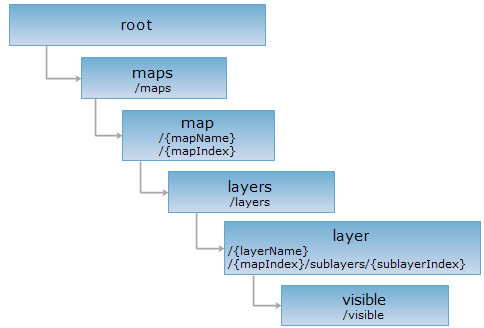
<layer_uri>/visible[.<format>]
As a child resource of the layer resource, the visible resource is used to identify if the layer is visible.
Supported methods
Supported output formats: rjson, json, html, xml.

Here is an example of performing an HTTP request on the following URI, with rjson as the output format. In the URI, supermapiserver is the name of the server, "WorldMap" is the map name (mapName), Capitals@World is a layer of Map "WorldMap" (layerName), Capitals@World@@WorldMap represents a sublayer of World layer. Therefore, the URI represents the visible resource of the Capitals@World layer.
http://supermapiserver:8090/iserver/services/map-world/rest/maps/WorldMap/layers/Capitals@World@@WorldMap/visible.rjson
Gets the description of the layer visibility. Returning true: visible, false: invisible.
| Field | Type | Definition |
| _cache | boolean | [Optional parameters] Whether to use cache, the default is True. False means close all the caches. |
Implement the GET request on the visible resource and you will get a boolean value that indicates if the layer is visible.
Implement the GET request on the visible resource with http://supermapiserver:8090/iserver/services/map-world/rest/maps/WorldMap/layers/Capitals@World@@WorldMap/visible.rjson and you will get a boolean value indicating whether the layer Capitals@world is visible as shown below.
true
Asks for the response identical to the one that would correspond to a GET request, but without the response body. This is useful for retrieving meta-information written in response headers, without having to transport the entire content. The meta-information includes the media-type, content-encoding, transfer-encoding, content-length, etc.
HEAD request can be used to check if the visible resource exists, or if the resource can be accessed by clients. It can also determine if the visible resource supports an output format <format> if performed on a URI with .<format> included.